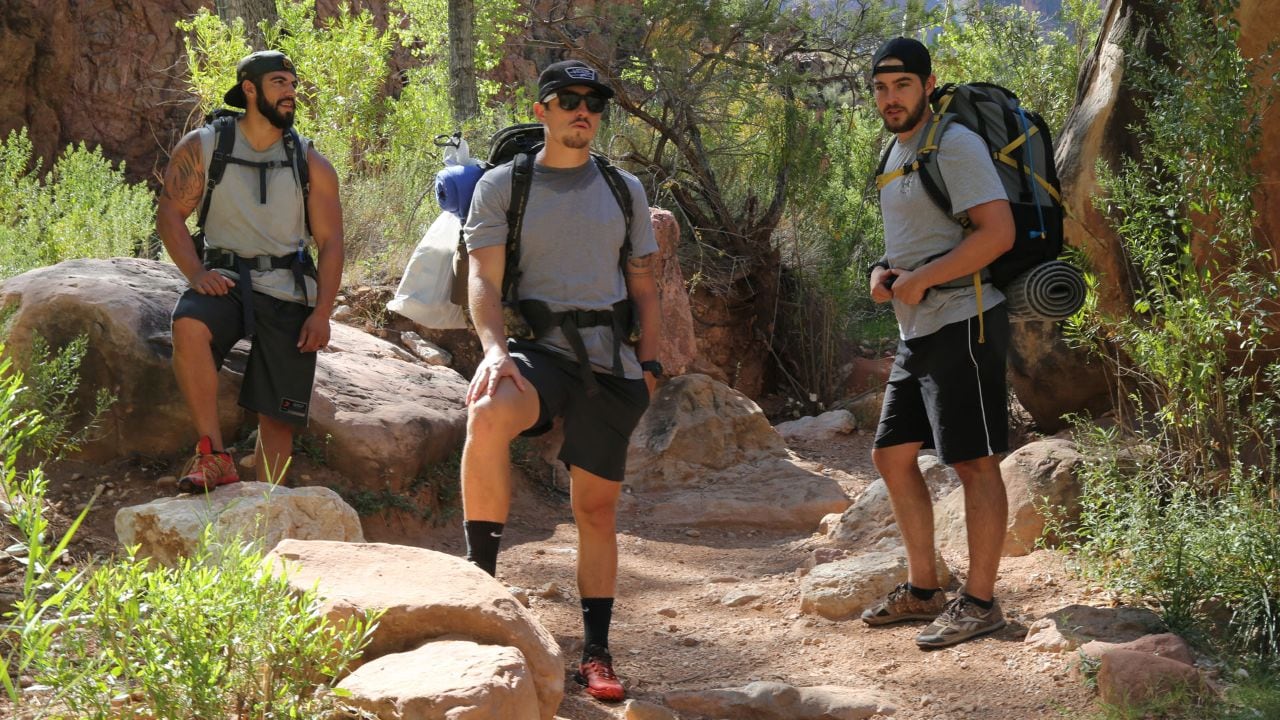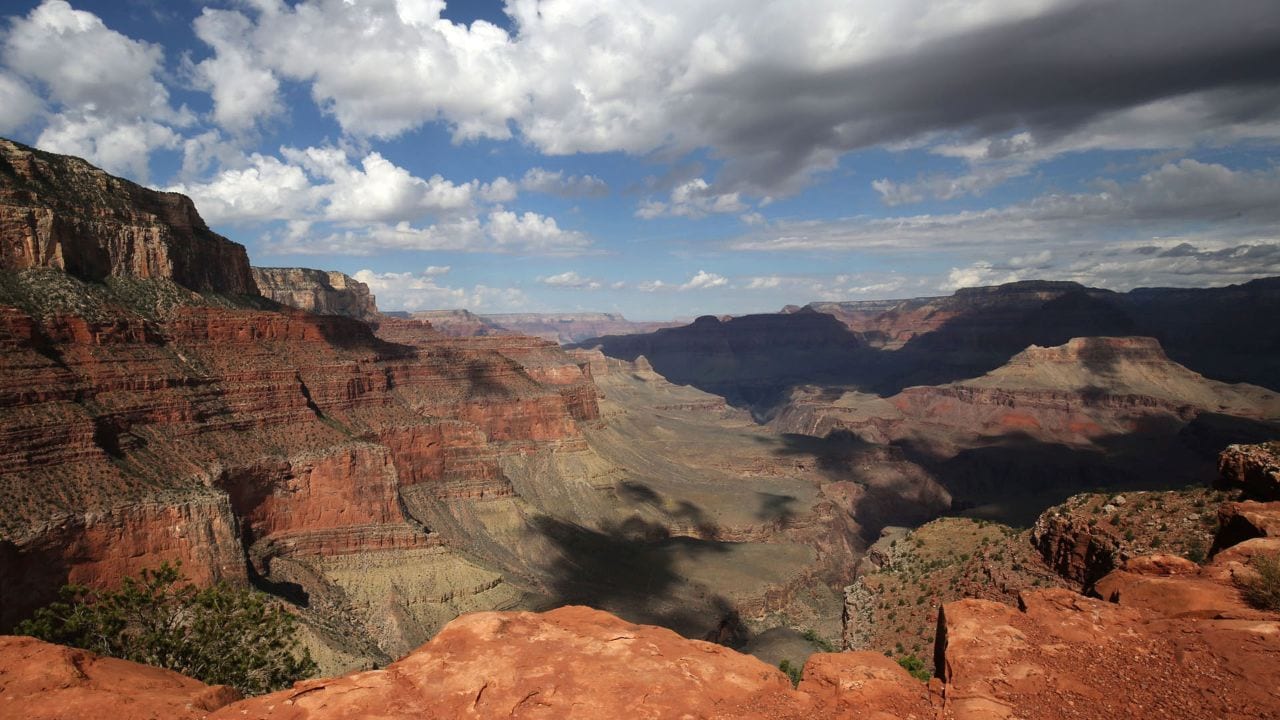Hiking to the bottom of the Grand Canyon

Story and photos by Charles Williams
Charles is the editor for Pursuits with Enterprise. Email the author.
Six family members immerse themselves in nature and attempt to bond.
Switchbacks aren’t something I encounter in daily life. So staring ahead at the final five kilometres of the Bright Angel Trail gave me pause. Like many potentially gruelling experiences, hiking the Grand Canyon wasn’t my idea.
After my dad died two years ago, I searched for a quotation for my mother’s luggage label to inspire her to travel alone for the first time in 58 years. I settled upon a simple one by John A. Shedd: “A ship in harbor is safe, but that is not what ships are built for.” In the process, I inspired myself to venture beyond my own comfort zone and embrace more risk.
More than 5.5 million people visit the Grand Canyon each year, but fewer than 1 percent descend to the bottom. I’ve been among the throngs—both on the North and South Rims—who marvel at the changing light and quickly move on. But this time, I wanted to challenge myself physically and mentally to truly experience, not just visit, one of the Seven Wonders of the Natural World.
Six of us started down the 12.6-kilometre South Kaibab Trail toward Phantom Ranch, which is at the bottom of the canyon. Three of us—myself and brothers John and Steve—represented the eager over-50 crowd. The other three—nephews Justin and Taylor, along with my niece’s husband, Daniel—were all in their 20s. The hike was meant to be a family bonding experience, but as I would soon find out, nobody wants to bond with a slowpoke.
The South Kaibab Trail is steep, and heavy rain the night before left puddles of water everywhere. As we descended, distractions faded and the minimalist landscape offered a mirror for personal reflection—at least when we weren’t avoiding ubiquitous mule droppings.
The Grand Canyon is 446 kilometres long and up to 29 kilometers wide, meticulously carved by the Colorado River over 3 to 6 million years. It’s easy to be mesmerized by its beauty, especially when light changes the appearance of the sculpted walls. At times, hikers become so focused on not making a misstep that they forget to stop and revel in the grandeur. We stopped after 1.6 kilometers, affixed our widest angle lenses and captured the stunning scenery.
Justin, Taylor and Daniel showed no interest in slowing down for pictures or anything else, and they sailed to the bottom without us.
Unfortunately, the slow-moving crew—Steve, John and I—began to experience headwinds. We started at 8 a.m., and our original goal was to reach the bottom in half a day. But as the sun rose and the heat increased, our new goal became more noble: to reach the Phantom Ranch cantina before it closed at 4 p.m. “Cold beer!” became the rallying cry when weary knees buckled under constant pounding.
John’s hiking boots began to disintegrate in the sweltering heat—first one toe, then the next, followed by a heel—which led to a nasty fall and bloody knees. I imagined the buzzards circling.
We finally reached the bottom at 4:05 p.m. The cold libation I’d been dreaming about for the last four hours had evaporated 300 seconds ago. By this time, the boys had cooled off in the stream, visited the cantina, gone for another dip, and wet their whistles again. They contemplated hiking back out at night while I thought about faking an injury to be helicoptered out. Neither happened.
Despite the downhill travails, there was a sense of achievement upon arrival at Phantom Ranch. It has been operating since 1922 and it just might be the toughest reservation you’ve ever tried to get. Cabins, campsites and dorm rooms fill up 13 months in advance. I was lucky enough to get a bed in an air-conditioned, 10-person dorm room.
The view from the bottom is unique. From the rim, the Colorado River is a thin ribbon. But here, it is a raging torrent, no doubt fuelled by the downpours. The canyon’s walls rise almost 1.6 kilometres, providing a perspective that’s unmatched, and as the sun fades and the stars appear, you know you are somewhere special.
The cantina doubles as a restaurant that serves stew, veggie or steak dinners. They’re not cheap, but considering that you don’t have to carry food down, they’re worth it. Sides are all-you-can-eat and plentiful. Splurge. After all, you’ve joined the one percenters.
While other dorm dwellers went to bed at 7:30 p.m., I elected to visit the cantina, which had reopened at 8 p.m. The guys swapped opinions over rounds, steering clear of anything too emotional or substantive. I was taunted for using too strong of a sunscreen (SPF 70) and told my best drinking days were behind me—points I was reluctant to argue.
At 4:30 a.m., someone pounded on the dorm door. “First breakfast wake-up call!” he shouted. Night owls be warned; you won’t be sleeping in at Phantom Ranch.
Fortunately, the handy park ranger was able to repair John’s hiking shoes with the help of five screws and a good supply of tape. Frankenfeet would march on.
We had a late breakfast and decided to take the Bright Angel Trail out. Although it’s longer, at 15.4 kilometres, it seems more pleasant, especially the first few kilometres that run along the river and streams. The trickling water, cool shade and relatively easy trail grade made this my favourite part of the Grand Canyon hike.
Naturally, the boys powered ahead and met us at Indian Garden, the halfway point for the Bright Angel Trail and a great rest stop. We enjoyed dehydrated food—as much as that’s possible—and talked about our original plan to camp overnight there. Why push it when the return trip could be spread out over two days? We debated the pros and cons, and in the meantime, the boys went ahead—with the tent and stove in tow—which made the decision easy for us.
On the way down, Taylor carried some of my clothes in his backpack in exchange for beer money. I figured my back was worth a few bucks. Now the boys were pleading to carry the heavy stuff to the top without compensation just to make sure we made it out alive. Charity begins at home.
The final 8-kilometre slog of switchbacks was challenging. The air became thinner, but the views remained beautiful. John and I were the last to make it out just as darkness enveloped the canyon.
Everyone who hikes to the bottom of the Grand Canyon will have a different tale, depending on weather, conditions and expectations. But just the mention of the trek draws universal admiration—both from those who have done it and those who have it on their bucket list.
Half of us hiked to the bottom of the Grand Canyon for the first time; the other three had just finished their third trip. The National Park Service says people either can’t wait to get back or swear they will never do it again. I fall somewhere in between. The hike was harder than I expected, but the risk resulted in tangible rewards—gorgeous scenery, renewed family connections and a sense of personal achievement.
Despite being tossed about by waves of doubt, I did something that few people experience in a place unlike any other. With the challenge behind me, this vessel will rest, not rust, in port before venturing to new destinations.
Road trip to see waterfalls in Tennessee
A loose travel itinerary allows for discoveries around every turn.
San Francisco: A gateway to Yosemite National Park
An easy road trip takes you from a world-class city to a top national park.
Blown Away by Oregon’s Volcanic Legacy
Mount Hood, Smith Rock and Crater Lake are high spots of the state’s interior.
A Road Trip Through the Great Smoky Mountains
A national park and nearby parkway offer stunning views of the ancient Appalachians.
Utah’s Scenic Byway 12 is a Masterpiece
The All-American road traverses slickrock and features a petrified forest, a beautiful waterfall and gourmet dining.
Driving Through America the Beautiful
A trip from Denver to Montana shows off the vast and varied scenery in the U.S.
Acadia National Park fuels photography passion
The only national park in the Northeast has stunning fall scenery and unique carriage roads.
Hiking to the bottom of the Grand Canyon
Six family members immerse themselves in nature and attempt to bond.




































